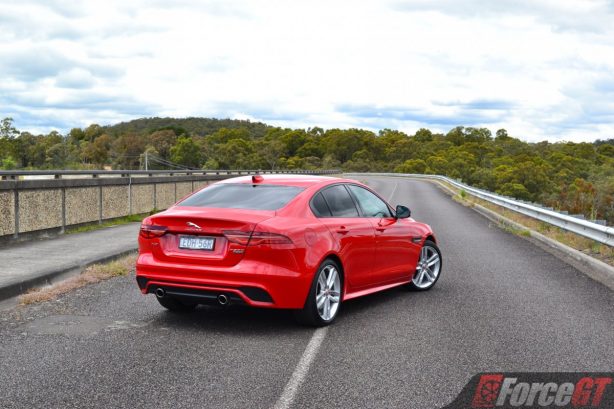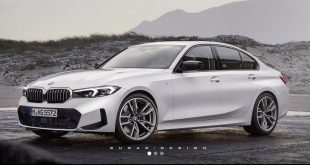There is a lot to like about the Jaguar XE. Our first drive of the baby Jag in range-topping S form back in 2017 had us impressed with its superb driving dynamics, potent F-Type derived supercharged powertrain and lusty good looks. Yet, there was room for improvement. The transmission wasn’t the most polished and the interior had a few missed opportunities.
For 2019, the Jaguar has given the XE a thorough top-to-bottom makeover, while simplifying its line-up – here in Australia at least – to just a single powertrain offering. The XE is arguably the British luxury marque’s most important model, as it plays in the popular premium compact executive segment, going up against the established German trio of Mercedes-Benz C-Class, BMW 3 Series and Audi A4, plus strong rivals Volvo S60, Lexus IS and Alfa Romeo Giulia.
How does the facelifted model-year 2020 Jaguar XE stack up against a tough competition set? Let’s find out.
What’s new for 2019?
Simplified from 15 variants when the XE first went on sale in 2015, the 2019 line-up is now available in just the sport-focused P300 R-Dynamic SE and HSE trims, both powered by the 221kW/400Nm 2.0-litre Ingenium turbo petrol engine shared with the E-Pace compact crossover and Range Rover Velar mid-size SUV. The engine is paired exclusively with an 8-speed automatic transmission.
The rejigged XE range means Jaguar will no longer offer the previous 3.0-litre supercharged V6 in the S performance variant and 2.0-litre turbo diesel model.
The XE has always been a great looking saloon car and the new facelift has given it an even more purposeful and assertive stance. At the front the new full LED headlights are slimmer as they merge toward the grille, giving the car the ‘look of a cat about the pounce’. They also get a more pronounced ‘J’ blade daytime running light signature. The front bumper has also been restyled with a larger intake aperture.
The R-Dynamic trim now gets a more distinctive rear bumper design to further differentiate it from the rest of the range (not that it matters here in Australia as only R-Dynamic is offered), while the all-LED taillights mimic the front with a slenderer design to accentuate the visual width of the car.
Down the side, the side skirts are now painted body colour instead of gloss black to give the car a lower visual stance.
Our test car is fitted with the optional 19-inch 5 split-spoke wheels in gloss silver ($1000) which no doubt look much better than the standard 18-inch items, but if budget permits opt for the larger 20-inch alloys ($1850) as seen in our 2017 XE tester for that maximum visual impact.
Highlight of the updated interior is the new steering wheel, shared with the all-electric I-Pace and features hidden-until-lit graphics and tactile switches.
Also shared with the I-Pace, the XE gets Jaguar’s new Touch Pro Duo infotainment system which is standard on the HSE trim but part of the optional $2160 Technology Pack in SE grade. It essentially replaces the conventional climate and audio controls with a touchscreen. Together with the infotainment touchscreen above, the pair of high-resolution displays eliminate most of the buttons and knobs in the centre console for a cleaner look.
For 2019, DAB+, as well as Apple CarPlay and Android Auto smartphone mirroring have been made standard, though wireless device charging is still optional (part of the aforementioned Technology Pack).
What’s it like on the inside?
While the 2019 updates for the XE have focused on adding a wider range of comfort and technology-related features, a large part of the refresh has also emphasised on improving the interior. The pre-update cabin copped widespread criticism for the odd location of the power window switches and questionable trim materials in certain areas. Well, it seems Jaguar has taken all those critics seriously and gone to work.
The new interior of the 2019 XE is a significant step up from before, with a noticeable lift in the quality of the materials and an overall tighter fit and finish. The odd-ball rotary gear shift knob is gone and in its place a more conventional stick shifter carried over from the E-Pace. The plasticky trim surrounding the shifter has also been replaced with a more premium looking gloss black trim to match the rest of the centre console.
Just fore of the gear shifter, the centre cup holders now have a sliding cover over them which when closed provides a grippy surface for placing your phone or other small items.
We totally dig the new futuristic steering wheel, which not only looks absolutely fantastic but also falls nicely to hand. And if you think the hidden-until-lit buttons are a bit too space-age, afraid not as they are just as easy to use as conventional steering wheel buttons.
The paddle shifters mounted behind the wheel feel expensive and look beautiful with their all aluminium construction, a far cry from the old scratchy plastic items.
Elsewhere, the door cards have been totally redesigned, and for the better of it. Heeding critics, Jaguar has moved the power window switches from higher up in the door to a much more comfortable location at just before the door grab, which itself is in a new location and larger than before.
Overall, the new XE interior exudes a much more premium feel than before and is now on par if not better than the best from Germany.
Now let’s talk about the Touch Pro Duo. While the infotainment touchscreen interface is fairly intuitive, the one below it takes a bit of getting used to. Make no mistake though, it looks pretty darn fancy, with two physical knobs and touchscreen integrating seamlessly together. The problem is the knob combines temperature adjustment with seat heating and fan speed functions – rotate to adjust the temperature, pull and rotate to adjust fan speed and push and rotate to set seat heating. This means it requires an additional step to get to the fan and heating functions.
The Touch Pro Duo also failed to load on start up on two occasions during the week we had it, losing all climate control and navigation functionality.
Cabin space is no more generous than it was in the pre-update model. The front occupants get plenty of space but it is pretty tight in the rear. Taller back seat passengers will find their heads scrubbing against the roof liner or their knees bashing against the front seat back. It’s worse for the unlucky one seated in the middle rear seat as they will have to put up with its raised position – more scrubbing against the roof – and the massive driveshaft hump.
For those digitally connected rear passengers, it’s sad to say that there’s no USB port in the back.
At the back the XE’s 455 litres of boot space is down on the Germans but can be augmented by the optional 40/20/40 split rear seats ($460).
What’s under the bonnet?
As mentioned, you can have any engine in the XE as long as it’s the 2.0-litre four-cylinder turbo petrol unit. It develops a respectable 221kW at 5500rpm, accompanied by a strong 400Nm of torque from 1500 to 4500rpm, all channeled to the rear wheels. It’s one of the most powerful 2.0-litre engines in the segment, capable of hauling the 1523kg sports sedan from 0 to 100km/h in a claimed 5.9 seconds.
It doesn’t feel that quick in real though and the 8-speed torque converter auto is to blame with its slow shift and poor calibration (more on that later).
Fortunately, the XE makes the kind of noise you’d expect from a Jag, with the turbo four sounding properly enthusiastic and raspy once uncorked.
Still, there’s no match for the XE S’ supercharged V6 both in terms of drama and performance. Here’s hoping that Jaguar would bring the V6 back to the line-up and reignite the fight against the AMG C43, S4 and M340i.
What’s it like to drive?
The XE’s greatest trait has always been the way it drives, and it continues to impress three years on even in non S guise. One of Jaguar’s main focuses since reinventing its brand image in the late noughties has been distinctly on handling, and the XE is a perfect example of just how good Jag’s dynamic and chassis tuning team is.
On a stretch of challenging roads, the XE truly has a genuine edge against the competition – and this includes the 3 Series. The chassis is superbly neutral and balanced, which allows for super sharp turn in with next to no understeer. There’s amazing grip from those Pirelli P Zero tyres which allow you to take corners at stupid speeds. Feed in power mid corner and you can even tighten its line further, that’s how throttle adjustable the XE is.
The steering is precise, well weighted and provides good feedback for an electric rack, while the paddle shifters have good response time. It’s just a shame that the transmission doesn’t shift quite as quick as rivals’ torque converter ‘boxes and simply no match for snappy dual clutches.
Still, the XE is one of the most engaging and finest handling sports sedans around, perhaps second only to the Alfa Romeo Giulia.
You might think its dynamic prowess comes in the expense of ride comfort. No, not at all. Around town, the XE’s well judged suspension polishes bumps and ruts with aplomb, even in sports-focused R-Dynamic tuned. It’s not a Camry so it does ride on the firm side and lets you feel just enough of the road – which is exactly how a sports sedan should be – but it’s never harsh and intrusive. It’s brilliantly balanced. The XE is perfectly suitable as a daily, yet always ready for the weekend spirited drive.
There’re a few issues though. You feel the gearbox’s last couple of downshifts when slowing to a halt, which is unnecessary as it robs away low speed refinement, and the auto idle stop start (can be turned off) isn’t throttle adjustable, activating every time you come to a stop which is annoying when you’re just trying to inch through slow moving traffic.
Then there’s the speed sign recognition which somehow struggles to correctly read our posted speed limit.
How economy is it?
The XE is claimed to return an average combined fuel consumption of 6.9L/100km, which seems a bit optimistic. On test, we achieved an average of 9.5L/100km with mainly urban driving plus plenty of seat time around our regular twisty test routes. Not bad for a performance sedan.
All XE models are offered with a fixed-price service plan which costs $1750. The once-off cost covers servicing of the car for five years or 100,000, whichever comes first. Service intervals for the XE in four-cylinder petrol form are 12 months or 16,000km, whichever comes first.
Verdict
Design & Comfort
Performance & Handling
Quality
Economy
Equipment & Features
OUR SCORE
4.1/5
+ Plus
- Excellent ride / handling balance
- Superb dynamics and engagement
- Major leap in interior presentation and quality
- Handsome looks
– Minus
- Cramped rear seats
- No more V6
- Some electronic maladies
Overall
With the XE, Jaguar has given us a quintessential sports sedan in its purest. It’s for people who love driving but need some room in the back for the occasional rear passengers. It’s so good at putting a grin on your face that it makes you want to drive it everyday, and it can because its ride and handling balance is simply brilliant. It will slug through the urban crawl no dramas and it will tear down back roads as fast as some sports cars. And lastly, it’s strikingly good looking.
A couple of electronic maladies and some minor gruffness aside, the Jaguar XE is a very convincing sports saloon and the new updates have polished it up a few notches. But it needs more engine options and the return of a stonking V6 to go up against a very tough competition set.
2019 Jaguar XE P300 R-Dynamic pricing and specification
| Pricing (Excluding on-road costs): | From $65,670 As tested: $74,390 (R-Dynamic SE) Tested options:
|
| Warranty: | 3 years/unlimited kilometres |
| Warranty Customer Assistance: | 3 year roadside |
| Country of Origin: | United Kingdom |
| Service Intervals: | 12 months/16,000km |
| Engine: | 2.0-litre four-cylinder turbo petrol: 221kW @ 5,500rpm, 400Nm @ 1,500-4,500rpm |
| Transmission: | 8-speed automatic |
| Drivetrain: | Rear-wheel drive |
| Power-to-weight Ratio (W/kg): | 145.1 |
| 0-100km/h (s): | Claimed: 5.9 / Tested: 6.3 |
| Combined Fuel Consumption (L/100km): | Claimed: 6.9 / Tested: 9.5 |
| RON Rating: | 95 |
| Fuel Capacity (L): | 63 |
| Safety: | 5-star ANCAP, 6 airbags, ABS, BA, EBD, ESC, Lane Departure Warning, Autonomous Emergency Braking (AEB), Torque Vectoring by Braking, adaptive lighting, turning light and automatic high beam assist, reverse camera, front and rear parking sensors, ISOFIX |
| Dimensions (L/W/H/W-B) mm: | 4,678/1,850/1,416/2,835 |
| Kerb Weight (kg): | 1,523 |
| Towing Capacity (kg): | Braked: 1800; Unbraked: 750 |
| Entertainment: | 10-inch Touch Pro, AM/FM, Bluetooth, USB, AUX, iPod, Apple CarPlay, Android Auto |
Competitors: Audi A4, BMW 3 Series, Lexus IS, Infiniti Q50, Mercedes-Benz C-Class, Volvo S60, Alfa Romeo Giulia, Genesis G70
 ForceGT.com Car News, Car Reviews, Video Reviews, Tuning and much more.
ForceGT.com Car News, Car Reviews, Video Reviews, Tuning and much more. 






































